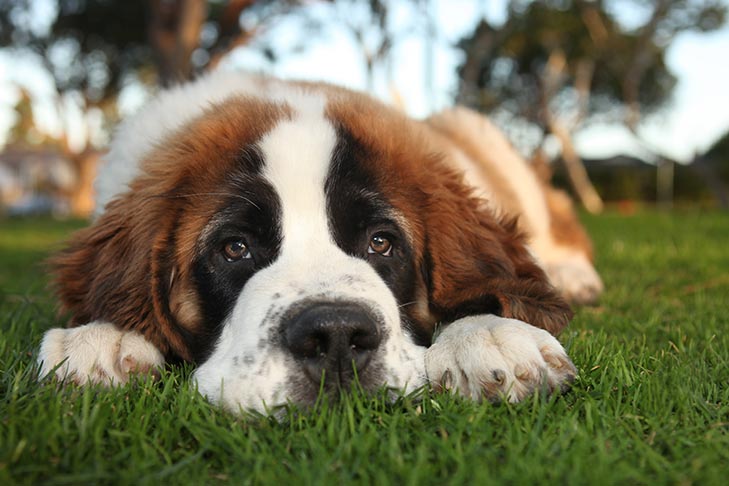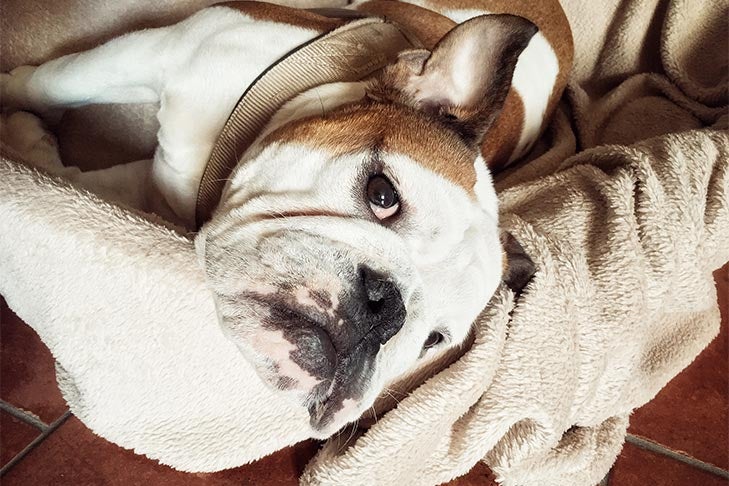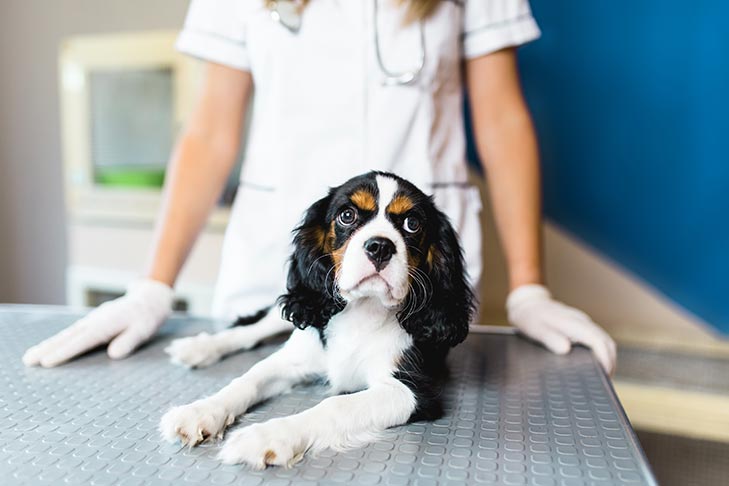- July 15, 2022
- No Comment
- 13 minutes read
Dog Anxiety: What Dog Owners Need to Know – American Kennel Club

Just like humans, dogs experience anxiety. While unpleasant, it is a normal and also healthy emotion. Dog anxiety can affect all breeds, but may affect each individual dog differently. Although it is something that all dogs experience from time-to-time, if disproportionate levels of anxiety are left unchecked, a dog can develop an anxiety disorder. If left untreated, dog anxiety can lead to behavioral and other issues.
How do you know if your dog has anxiety? What can you do to treat dog anxiety? We’re here to explain everything you need to know about dog anxiety — common causes, symptoms, and treatments. Additionally, we’ll discuss top tips for anxiety prevention. This way, if your dog ever does suffer from anxiety — you’ll have all the knowledge you need as an owner to help.
According to the Merck Veterinary Manual, dog anxiety can have a variety of causes. Some of the most common causes of dog anxiety are:
Fear-related anxiety can be caused by loud noises, strange people or animals, visual stimuli like hats or umbrellas, new or strange environments, specific situations — like the vet’s office or car rides — or surfaces like grass or wood floors. Although some dogs may only have brief reactions to these kind of stimuli, they may affect anxious dogs more consequentially.
Separation anxiety is estimated to affect around 14 percent of dogs. Dogs with separation anxiety are unable to find comfort when they are left alone or separated from their family members. This anxiety often manifests itself in undesirable behaviors, such as urinating and defecating in the house, destroying furniture and furnishings, and barking.
Age-related anxiety affects older dogs and can be associated with cognitive dysfunction syndrome (CDS). In dogs with CDS, memory, learning, perception, and awareness start to decline, similar to the early stages of Alzheimer’s disease in humans. This understandably leads to confusion and anxiety in senior dogs.
So how can you tell if your dog has anxiety? There are several important symptoms to look out for:
Some of these symptoms may be the result of occasional anxiety-causing events, but any of these can become recurrent and therefore, result in more serious issues. This being said, by far the most dangerous symptom of dog anxiety is aggression. This aggression can be targeted directly or indirectly, depending on the situation. Direct aggression occurs when a dog acts aggressively toward people or other animals. Indirect aggression can be equally dangerous, and often happens when a person comes between the dog and the source of the dog’s aggression, such as another dog. Even if a dog is prevented from harming others, aggressive behaviors such as growling or barking can lead to undesirable situations for humans and dogs, alike.
Urinating and defecating in the house is a common symptom of separation anxiety. Anxious dogs often work themselves up to the point that they pee or poop in the house, even if they are housebroken. This is frustrating for owners and can cause damage to property, not to mention the unpleasantness of the cleanup.
Destructive behavior is also common with separation anxiety. The damage is usually located around entry and exit points, like doorways and windows, but dogs in a state of heightened anxiety are also at risk of harming themselves. Attempts to break out of dog crates, windows, and even doors can result in painful injuries and expensive veterinary treatments.

The best way to treat anxiety is to talk with your veterinarian. Your veterinarian can help you identify the type of anxiety your dog suffers from and the possible causes and triggers. Your veterinarian will also be able to help you determine if the anxiety is simply situational, or if it is becoming an overwhelming issue for your dog. Additionally, veterinarians can also rule out any other medical conditions that could be causing your dog’s symptoms.
Your veterinarian will help you come up with a treatment plan. Since excessive anxiety is often caused by a variety of factors, the best way to treat it is usually through a combination of training, preventive strategies, and in some cases, medications.
There are several training strategies owners can use to treat dog anxiety. One way is counterconditioning. The purpose of counterconditioning is to change your dog’s response to the stimuli responsible for anxiety, usually by replacing the anxious or aggressive behavior with a more desirable behavior, like sitting or focusing on the owner.
Another training strategy is desensitization. The owner slowly introduces the dog to the source of anxiety, preferably in small doses and at a decreased intensity. Repeated exposure and rewarding positive behavior can go a long way toward managing anxiety.
You might want to contact a professional dog trainer to help you choose the best approach for your dog, as training an anxious dog is not always easy.
If your dog develops a serious anxiety disorder, your veterinarian may recommend medications or natural therapies. SSRIs and antidepressants are occasionally prescribed for dogs with anxiety, including fluoxetine and clomipramine. For predictable anxiety-producing events like thunderstorms, fireworks, or car rides, your veterinarian might prescribe a medication such as benzodiazepine in conjunction with an antidepressant to help your dog cope with the stress.
Senior dogs with cognitive dysfunction syndrome may benefit from the drug selegiline, which can help reduce some of the symptoms of CDS. Selegiline is also used for treating chronic anxiety in Europe.
The Merck Veterinary Manual also states that natural therapies and products can help dogs with anxiety. Some products work best in conjunction with other medications, while others can be used alone, depending on your dog’s case. Natural products use pheromones and aromatherapy to reduce anxiety. Talk to your veterinarian about the natural products best suited for your dog.
Some dogs owners have reported success in using CBD oil to treat dog anxiety. CBD is a compound found in cannabis and hemp that dog owners, as well as humans, have found useful for treating a variety of different health conditions. Anecdotal reports from dog owners claim that CBD oil can be effective in treating dog anxiety.
It’s important to note, however, that although many humans use CBD oil for anxiety treatment purposes, there is currently no scientific data on how using CBD oil affects dogs. Additionally, CBD products are not yet regulated — meaning consistency and purity are not always validated. Therefore, if you’re considering using CBD oil as a treatment for dog anxiety, it’s best to consult with your veterinarian. Your veterinarian can help you determine if CBD oil might be a good treatment for your dog’s anxiety, as well as discuss different products, possible side effects, and risks.
Learn about the CBD oil study being conducted by the AKC Canine Health Foundation.

It can be difficult to predict exactly what will make your dog anxious, and even more difficult to determine if your dog’s anxiety will develop into a more serious disorder. However, there are ways to help a dog or puppy avoid anxiety-related problems.
Body Language
One of the best things you can do is learn to read dog body language. Knowing when your dog is uncomfortable or scared can help you avoid negative experiences or use them as a positive training moment. Body language can also tell you when a dog is getting anxious, which is especially useful if your dog has a history of aggression-related anxiety.
Socialization
Proper socialization can prevent the development of anxiety. Introducing your dog to new people, dogs, animals, places, and experiences can help avoid an exaggerated response down the road, and also helps your dog become a well-adjusted canine citizen.
Obedience
Obedience training is an essential tool for preventing and managing dog anxiety. It lays the foundation of a healthy relationship and establishes trust. A well-trained dog is easier to socialize than a dog without training, and obedience classes are a great place for dogs to meet other dogs in a controlled environment.
Exercise and Nutrition
Regular exercise and stimulation are crucial for a dog’s development, physical, and mental well-being. A stimulated dog is less likely to pick up destructive behaviors, and good nutrition is equally important for your dog’s health. Making sure you take care of your dog’s physical and mental needs can help you prevent any behavior problems that don’t stem from anxiety, letting you know the areas where your dog needs the most help.
Situation Avoidance
If your dog has been diagnosed with anxiety issues, you can also try to avoid or prevent situations that trigger your dog’s anxiety. For example, if you know that your dog grows anxious around large groups of dogs, you should avoid dog parks. Avoidance does not mean that you need to put your life on hold, but it can reduce some of the stress on you and your dog.
If the source of the anxiety cannot be avoided, preventive measures like leashes, body harnesses, and, in some cases, basket muzzles, can prevent dangerous situations. Once you know your dog’s triggers, you can prepare for these situations ahead of time.
Like humans, many dogs will experience anxiety at some point throughout their lives. Although not all dogs will have anxiety that leads to a diagnosable anxiety disorder, it’s important to know the causes, symptoms, and treatment options involved with dog anxiety. Understanding these important facets can help you, as an owner, know the best ways to help your dog in anxiety-inducing situations. If you think that your dog might have an issue with anxiety, it’s best to consult your veterinarian — your veterinarian can diagnose your dog, rule out any other health issues, and help you develop a treatment plan that best fits your dog and lifestyle.
Innovet created a product line of full spectrum pure hemp oils void of dangerous compounds. Their USDA certified organic oil is formulated especially for animals and is also third-party tested to ensure consistency and purity. Innovet offers more than 50 affordable products to help pets manage anxiety, pain, as well as other conditions. Get more information about Innovet’s CBD products.
AKC is a participant in affiliate advertising programs designed to provide a means for sites to earn advertising fees by advertising and linking to akc.org. If you purchase a product through this article, we may receive a portion of the sale.

